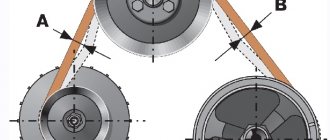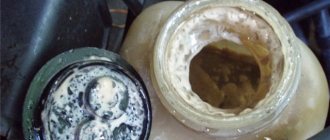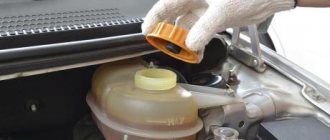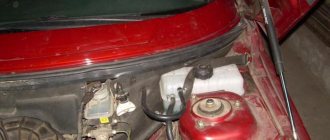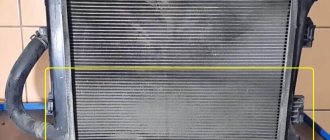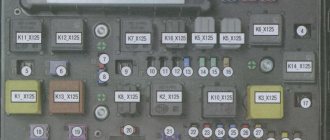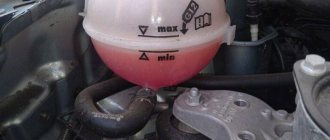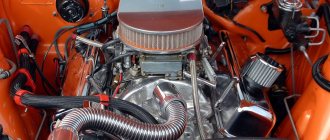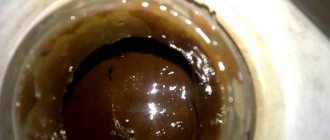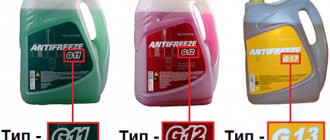Boiling antifreeze in the expansion tank in 90% of cases indicates engine overheating. If you don’t do anything, then there is a chance that you will end up with a jammed motor, the repair of which is not always advisable, and the cost of a new one will hit your pocket. So why does antifreeze boil in the expansion tank and what should you do if the temperature sensor does not indicate engine overheating?
Lack of antifreeze in the cooling system
Antifreeze, although slowly, still boils away; it has to be topped up periodically (2 - 3 times a year). Accordingly, the first step is to wait until the boiling stops, remove the cap of the expansion tank and add antifreeze (preferably the same brand as was previously used).
Some cars have 2 necks for filling antifreeze: through the expansion tank and the radiator. If the design is like this, then antifreeze is added to each of them up to the indicated marks (if there are none, then the instructions for the car contain recommendations from the manufacturer regarding the required volume of liquid in the cooling system).
Antifreeze leak
A lack of antifreeze in the system may indicate a coolant leak. In this case, after adding antifreeze, the engine can operate normally for 1–10 days, but then the problem returns again. Therefore, it would not be superfluous to conduct a detailed inspection of the pipes and connections to the expansion tank.
Leaks are often found on the radiator itself due to the appearance of cracks in it (it can only be eliminated by replacing it; it is recommended to install a copper one, although these are many times more expensive than aluminum ones).
Causes of malfunction
When antifreeze boils, the reasons for this phenomenon may be different. Experienced motorists are well aware of them . The most common :
- low level of coolant in the expansion tank;
- a malfunction in the thermostat;
- clogged radiator.
We recommend: Is it possible to mix antifreeze with antifreeze?
In any of these cases, the antifreeze is not able to cool quickly. His temperature is constantly rising. When this indicator reaches 120 degrees Celsius, the boiling process begins. This leads to a situation where the antifreeze begins to boil away.
Ethylene glycol is the main component of any coolant. This substance is a chemical compound that belongs to the group of alcohols. It is its presence that ensures the liquid state of the product in the cold. When it boils, the process of evaporation of ethylene glycol occurs. The main danger of this process is that the vapors of the substance are toxic and pose a serious threat to the human nervous system .
Low antifreeze level
If a car owner is faced with a problem such as antifreeze boiling on a VAZ-2114, then he first needs to check the level of technical fluid in the tank. However, this procedure should be carried out only after the antifreeze has completely cooled. If a deficiency is detected, then, depending on the situation, the following manipulations must be performed:
- If antifreeze has not been poured into the cooling system for a long time, it could simply leak out. If the level is low, it is necessary to top it up to bring the amount of technical fluid to the required level. When this is done, you can continue moving.
- In a situation where antifreeze was recently poured into the cooling system, and its level dropped to a critically low level, it is necessary to pay attention to the structural integrity of the tank. You should also inspect all pipes, as well as hoses and clamp connections for leaks of technical fluid. If a leak has been discovered, and there is no way to solve the problem right on the spot, then you need to use the service of a tow truck and drive to the nearest car service center.
If the level of antifreeze in the system is low, you cannot continue driving. Otherwise, you may encounter serious problems with the operation of the motor. Eliminating them can be costly.
Thermostat failure
As part of the cooling system, the thermostat acts as a device that regulates the temperature of the antifreeze. It is thanks to it that accelerated heating of the power unit is ensured. This device also allows you to maintain the required thermal conditions during its operation.
When the thermostat breaks down or the valve simply gets stuck in one position, the large circuit stops working. In such cases, antifreeze circulates only in a small circle. However, this does not allow it to cool completely. To determine if this part is broken, you need to turn off the engine and then open the hood. You should find the thermostat pipes and touch them carefully to avoid getting burned.
If the pipe connected to the main radiator is hotter than the others, this may indicate some kind of problem with the operation of the device. In this situation, the most reasonable solution is to travel to the nearest service station to replace the device.
Even with such a malfunction, you can continue moving further, but at low speed. In this case, every 5 km you should stop and perform the procedure of adding water to the expansion tank. But this operation can be carried out only after the power unit has cooled. Then you can easily get to the service center and replace the faulty device.
Radiator problems
Antifreeze boiling can also occur if the radiator stops working. This malfunction may occur in the following cases:
- During operation, a layer of scale may appear on the tubes of the product. This leads to the fact that their thermal conductivity is noticeably reduced. When the number of clogged pipes increases, the ability of the radiator to cool the antifreeze passing through it decreases.
- There is dirt in the radiator or the tubes are completely clogged. If such a problem occurs, it leads to a decrease in coolant circulation. In advanced cases, this process stops altogether. As a result, the temperature of the antifreeze increases - it boils.
- A problem with the radiator can also arise if the fan fails. Then the product does not have the ability to cool the antifreeze to the required temperature. The car owner can independently determine that the malfunction occurred in the fan. This can be done by ear. If the car engine is quiet when starting, it means it is not turned on.
In any of these cases, you can continue moving, but there is one caveat. It is necessary to stop every 8 km to allow the engine to cool down. Otherwise, problems with the engine cannot be avoided.
Thermostat is faulty
The car's cooling system is divided into 2 parts: a small and a large circuit. Antifreeze does not enter the large circuit until it warms up to 70 - 80 degrees. Next, a special valve opens (a thermostat that responds specifically to heating) and the coolant begins to circulate through the radiator.
If the thermostat is faulty, then antifreeze circulates only through a small circuit (which is not connected to the radiator). And the cooling of the antifreeze simply does not occur (the radiator is either completely cold or slightly warm). Because of this, the cooling system does not work properly and the engine overheats immediately after starting the engine.
How to check the functionality of the thermostat? If it is technically possible to remove it, then remove it and test it by placing the valve in hot water heated to approximately 90 degrees (the thermostat should “open”). If this does not happen, then the valve has definitely failed.
In cars where the thermostat cannot be removed, it is simply knocked out (since it was initially “pressed in”). Most likely, it will be damaged, so a similar procedure should be performed after purchasing a new thermostat in advance.
Consequences of boiling
What happens if the car engine boils? The consequences of engine overheating can be the most tragic for a car.
There are several degrees of engine overheating that occur as a result of boiling liquid:
- slight overheating of the motor;
- average engine overheating;
- severe overheating of the motor.
Slight overheating. If the overheating of the engine as a result of antifreeze boiling does not exceed 10 minutes, then the car owner can be said to be very lucky. This may occur if the fan or thermostat fails. If you notice the engine overheating in time (according to the temperature sensor on the instrument panel), then you should turn off the car as quickly as possible. In this situation, the worst thing would be if the engine pistons start to melt.
But this is not scary, especially for owners of new cars. As a rule, in new cars the consequences of such overheating will not be noticeable. You need to start panicking and take your car for repairs if you clearly see smoke starting to appear from under the hood.
Refrigerant boiling in the expansion tank
Medium overheating occurs if the boiling time of the liquid exceeds 20 minutes. In this case, the driver may face the following consequences:
- cylinder heads may become bent;
- cracks may appear on the cylinder head;
- cylinder block gaskets will melt or burn out;
- destruction of the inter-ring partitions on the engine pistons;
- Engine oil will begin to flow through the seals.
The two stages of overheating described above often occur as a result of poor or inattentive vehicle maintenance. But severe engine overheating from boiling antifreeze can be a real “heart attack” for your car.
If “Tosol” boils and the engine is very overheated, then the consequences, as a rule, cover all parts of the engine. But this is not the saddest outcome of events. The worst thing that can happen is if the motor explodes as a result of overheating. But this rarely happens, since often the car system allows the driver to avoid such a decoupling - the engine components are destroyed at different rates, as a result of which it simply stalls. The so-called “wave of destruction” extends to the entire motor and other components surrounding it:
- the pistons begin to melt and burn;
- molten metal from the pistons drips onto the cylinder walls, as a result of which the movement of the piston becomes difficult. Accordingly, the piston quickly fails and becomes unusable;
- if the car does not stall due to broken pistons, problems with the engine fluid may begin;
- overheated motor fluid immediately loses its lubricating properties, as a result of which all rubbing parts gradually begin to fail;
- after this, melted elements begin to stick to the crankshaft, which also complicates its operation;
- when the valve seats fly out, the crankshaft simply breaks into several parts under the influence of the piston;
- after this, the piston can pierce one of the walls of the cylinder block, and this, in turn, leads to complete engine failure.
Increased pressure in the cooling system
The cooling system is closed. But when heated, the liquid expands and the internal pressure increases. In many cars, to normalize it, a check valve is installed, which dumps “excess” antifreeze into the expansion tank. At the moment when that same “reset” occurs, the antifreeze in the tank literally “gurgles,” which inexperienced drivers regard as boiling.
But if this happens too often, then this may indicate a malfunction of the reverse valve (clogged, it gets stuck). A temporary measure is to remove this valve altogether (by connecting the pipe directly to the tank). But you should still install it at the first opportunity.
You may also be interested
Why antifreeze curdled: reasons and what to do
In some cases, a motorist may find foamed and heterogeneous rust-colored something under the cover. In this case, experienced drivers state: “The antifreeze has curdled.” Why does this happen and how to deal with it? This is exactly what we will discuss with experts in an article on our website.
Why antifreeze leaked, causes of leakage and what to do
An insufficient level of antifreeze leads to overheating of components and parts and disruption of the optimal temperature regime. Therefore, if a leak is detected, the problem should be addressed immediately. Otherwise, this can lead to serious consequences for the engine.
Burnt through cylinder block gasket
One of the most difficult breakdowns that causes antifreeze to boil. Burning through the gasket leads to the fact that antifreeze begins to flow from the cooling system into the cylinder block, where it burns out and ends up in the exhaust system. This is often accompanied by thick white exhaust fumes. And at the same time, the level of antifreeze in the cooling system regularly drops to a minimum, although visible leaks cannot be detected.
With such a breakdown, traces of engine oil may also appear in the expansion tank - it is “sucked” from the cylinder block. After eliminating the malfunction, cleaning the cooling system is mandatory.
Repair involves disassembling the engine and replacing the damaged gasket. Naturally, this should only be done by a specialist, since it will be necessary to re-adjust the location of the valves, install the camshaft in the correct location, and so on.
What is the most common reason for gaskets to burn out? The key ones can be identified:
- natural wear and tear;
- incorrectly performed installation earlier (not tightened, threads of tightening bolts not lubricated, etc.);
- poor quality gasket;
- use of used gaskets;
- regular engine overheating.
In this situation, it is impossible to do without detailed diagnostics of the operation of motors.
How dangerous is bubbling antifreeze?
This phenomenon is considered normal when the engine is warmed up to an operating temperature of 90–95 °C, provided that there are no losses of coolant, leaks outside the tank and other abnormal signs. Part of the antifreeze circulating in a large circle is discharged into the expansion tank. To an inexperienced car enthusiast, it may seem that it is boiling, although in reality an intense discharge is taking place.
Important point! A sign of serious danger to the engine is an increase in coolant temperature. If the device does not show it, overheating is excluded.
Not all seething is harmless. If it occurs on a cold engine and is accompanied by side symptoms, there is a reason to check the condition of the cooling system. What these signs and possible malfunctions look like:
- Antifreeze suddenly begins to bubble 2–5 minutes after stopping the engine. Most likely, the problem is a faulty valve built into the radiator cap. When circulation stops, the fluid in the cylinder head quickly heats up and increases in volume. Since the radiator valve is open, it rushes into the tank through the upper outlet pipe.
- Seething and drips on the expansion tank body indicate a stuck plug valve. Air and steam break out at a weak point - along the plastic thread, but they can also “explode” the container.
- There is a large amount of white smoke coming out of the exhaust pipe, and streaks are visible on the cylinder block. The reason is a broken gasket between the block and the cylinder head. The gas pressure created by the pistons is transmitted to the cooling system, causing the antifreeze to bubble and boil in the expansion tank.
Note. Often, a crack in the gasket connects the water channels with the oil channels. Then a foamy substance is noticeable in the container - an emulsion whipped by a pump.
It is not difficult to guess that a breakdown of the cylinder head gasket is a critical malfunction that must be corrected immediately. Problems with covers and built-in valves are not so fatal, but they lead to large losses of antifreeze and the same overheating, as indicated by frequent turning on of the fan.
Pump faulty
The circulation of the coolant is ensured by a circulating pump (pump), which is driven either by a belt drive or by an electric motor. If the pump stops pumping antifreeze, then it simply will not have time to cool, flowing through the radiator. As a rule, with such a breakdown, the “Check” signal lights up on the dashboard. Repair - replacing the pump with a new one.
In engines where the pump is driven by a belt drive (found mainly in older cars), you should also check that the belt is not slipping. This can occur due to the ingress of oil, antifreeze, or water (in rainy weather).
Fan doesn't work
The fan is installed behind the radiator and creates a powerful air flow, which cools the coolant flowing through it. If it is faulty or does not turn on (because the temperature sensor has failed), then the radiator will not be ventilated enough, and accordingly, the engine temperature, although slowly, will rise to a critical level of over 110 degrees. This happens mainly in the warm season, since in winter and without a fan the radiator will cool normally at average engine loads.
Repair - either replacing the fan or temperature sensor. As a temporary measure, you can consider removing the temperature sensor and connecting the impeller directly to 12V (to the battery). In this case, it will work continuously without turning off (only when the ignition is on).
Air blockage
If air gets into the cooling system, a pneumatic plug is formed, due to which antifreeze simply does not circulate through the radiator. Mostly this occurs when small holes appear in the pipes or in the radiator itself (air is “sucked in” through them). In this case, antifreeze almost immediately boils in the expansion tank after starting the engine.
Repair involves eliminating the hole; the easiest way to find it is through a thorough inspection of the cooling system with the engine running. It is necessary to find exactly where the liquid is leaking.
Low ambient pressure
You may encounter something similar while traveling. The fact is that the higher the car is above sea level, the lower the boiling point of the coolant. These are the simplest laws of physics, known from school.
If at an altitude of 0 meters above sea level the boiling temperature is in the range of 100 - 110 degrees, then at an altitude of 2.5 - 3 km antifreeze will begin to boil at 85 - 90 degrees. But the engine should not overheat. This is not a breakdown, but a natural behavior of the coolant.
Prevention
To avoid boiling of the refrigerant, it is necessary to fill in high-quality antifreeze. If before the replacement the car worked smoothly, but after replacing the coolant boiling occurred, then the problem is low-grade antifreeze. A fake is a substance that boils away at a temperature of 90°C. In this situation, it is necessary to drain the refrigerant and flush the entire system.
When buying antifreeze, the driver should pay attention to some nuances. The boiling point and boiling pressure are written on the packaging. To prevent the engine from overheating, you should set the value to 95 degrees on the instrument panel in advance. Having reached it, the engine will start the fan.

